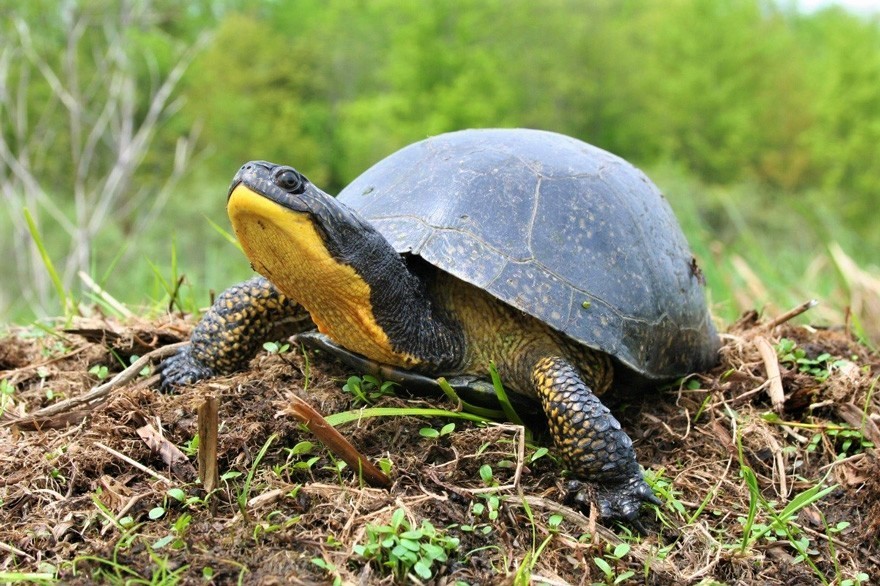
‘A shame and travesty’: Despite damning audit, PCs double-down on harms to species at risk
After a scathing audit condemned successive provincial governments for what is nothing short of a total failure to enforce species at risk legislation, Ontario’s PC government is refusing to be held accountable for fixing a system the auditor general says is actively harming species at risk in the province.
The government is now misleading residents about the process.
Bonnie Lysyk’s audit, released in November, highlighted how in the more than 10 years since Ontario’s Species at Risk Act came into effect, governments have failed to enforce provincial laws. They were designed to limit development in habitat of species at risk, but successive governments have done next to no enforcement to ensure that mitigation measures approved as part of development permits—measures meant to keep the harm to species at risk to a minimum—are actually being completed.
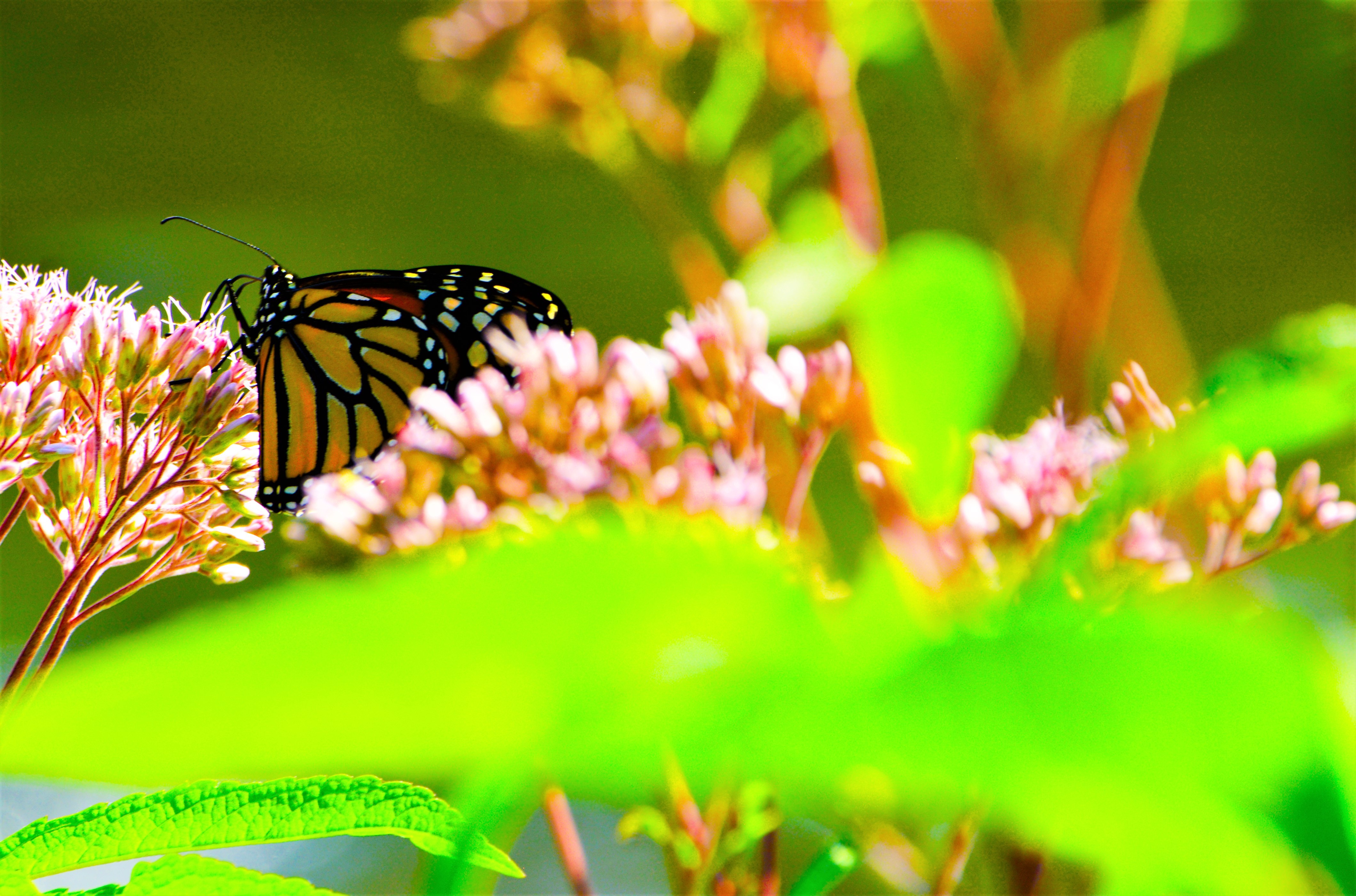
The Monarch Butterfly is one of many species of "concern" whose habitat in Ontario has been under threat due to development.
(Photo from Joel Wittnebel/The Pointer)
“The purpose of species at risk legislation is to serve as the last line of defence when other programs have been ineffective in conserving nature or have directly contributed to biodiversity loss. The Environment Ministry is not, however, acting in the best interests of species and their habitats,” Lysyk’s audit exposed. “The Environment Ministry’s systems and processes for approvals facilitate and enable harm to species at risk and their habitats.”
Among Lysyk’s major findings:
-
the committee tasked with advising the government on implementing species at risk law is dominated by industry stakeholders “whose interests can be contrary to protecting species at risk and their habitats”. Ten of fifteen members of the committee work for industry associations or companies; half of those ten are registered lobbyists, including members of the Ontario Forest Industries Association, the Ontario Home Builders Association and the Ontario Stone, Sand and Gravel Association
-
the Province has never denied a permit to harm species at risk or their habitat; permits to harm species at risk have increased more than 6,000 percent since 2008. Most of the permits are approved automatically
-
the committee which recommends species to be listed as endangered, threatened, or of special concern—the Committee on the Status of Species at Risk in Ontario (COSSARO)—did not have enough members appointed to function for two years, creating a backlog of 46 species in need of assessment
-
there is no analysis of government action to judge its effectiveness at protecting species at risk; there is no study of the cumulative impacts of development in Ontario on species at risk; and the government has said it has no plans to study these items
-
Recovery plans and strategies for several at-risk species have been delayed for numerous years; the plans that are in place are generally ineffective at improving the status of at-risk animals
-
the Province does not perform inspections to ensure contractors and developers are implementing the mitigation measures proposed to protect species at risk; the auditor general found examples where mitigation measures put in place as part of the permitting process are ignored, leading to direct harm to endangered species
-
permits for development are fast-tracked while those for conservation work are delayed. The auditor found examples where delays likely contributed to the Massassauga rattlesnake becoming locally extinct in one area
-
the PC government dismissed members from COSSARO with no explanation, despite their willingness to continue serving, and replaced them with appointees who lack necessary experience or expertise. The Minister of Environment appointed five individuals in 2019/2020 who were not screened or recommended by staff.
Esteemed naturalist and ornithologist Jim Richards, after learning of Auditor General Lysyk’s report on the government’s handling of species at risk legislation, attempted to get answers from his local MPP in Orono, which happens to be Minister of the Environment David Piccini, responsible for one of the key ministries obligated to ensure the Species at Risk Act is followed by the government.
“As my elected member of the Ontario Legislature, I would like to hear from you about endangered species here in Ontario. What is your position on the serious erosion of critical legislation to protect vulnerable species and the diversity of our threatened wildlife?” Richards wrote in an email to Piccini shared with The Pointer. “What action will you take to ensure that damage to legislation designed to protect all species in Ontario will be remedied?”
Instead of hearing back from his local elected representative, a response to Richards’ concerns came from an MPP Liaison in Piccini’s office.
His response was filled with misleading information on the PC government’s handling of species at risk.
“In 2019, we modernized and improved the effectiveness of the Endangered Species Act, 2007 (ESA) by implementing recommendations received as part of the 10 year review of the Act. This includes improving transparency when it comes to notifications of new species listings and enhancing government oversight and enforcement powers,” the response from Piccini’s aid states.
The claim is demonstrably false.
The “modernization” referred to in the response—enacted as part of the controversial Bill 108—has been widely panned for creating further exemptions for developers to harm species at risk, and delaying the addition of new species to the species at risk list which provides protection to vulnerable wildlife.
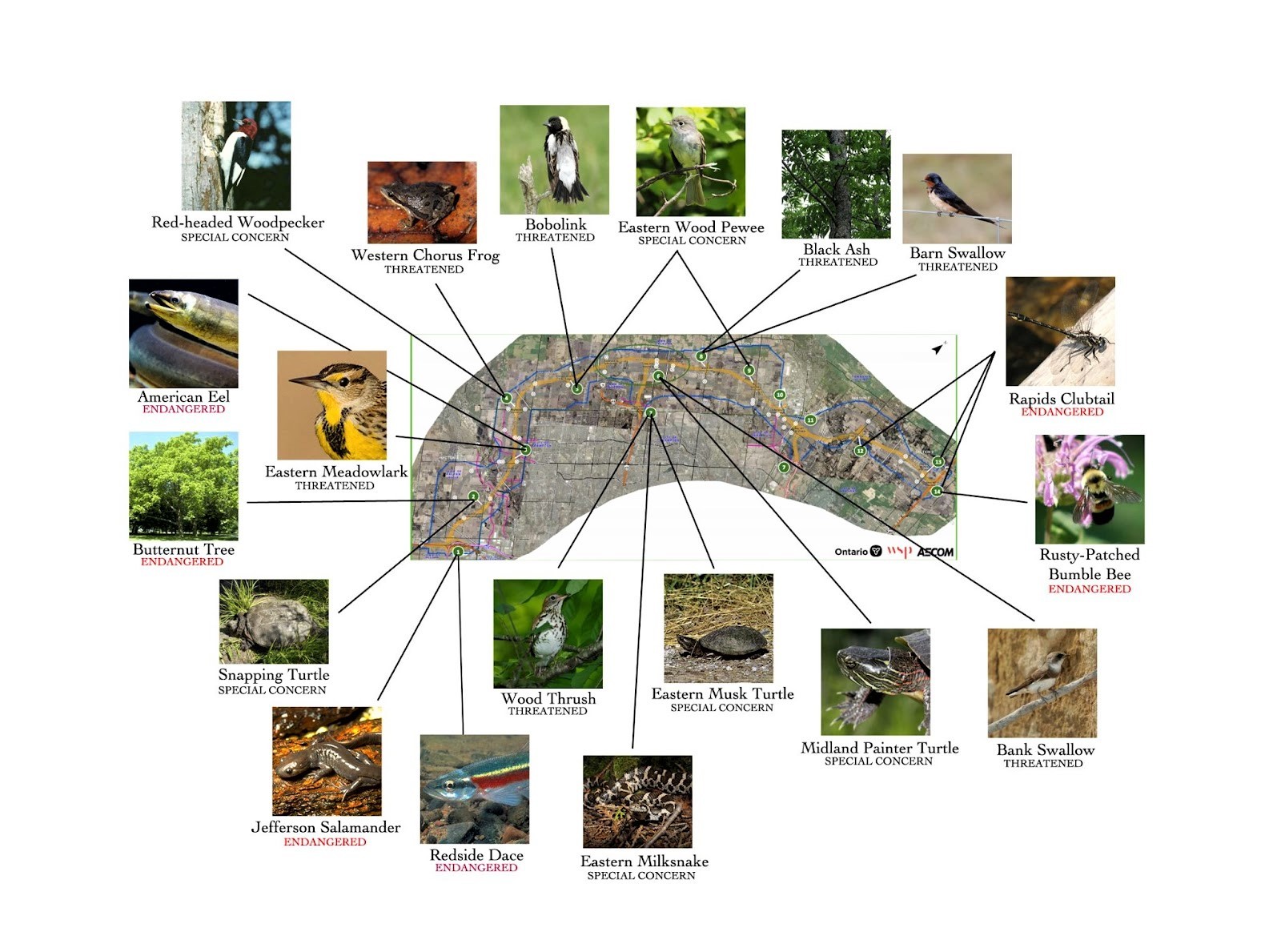
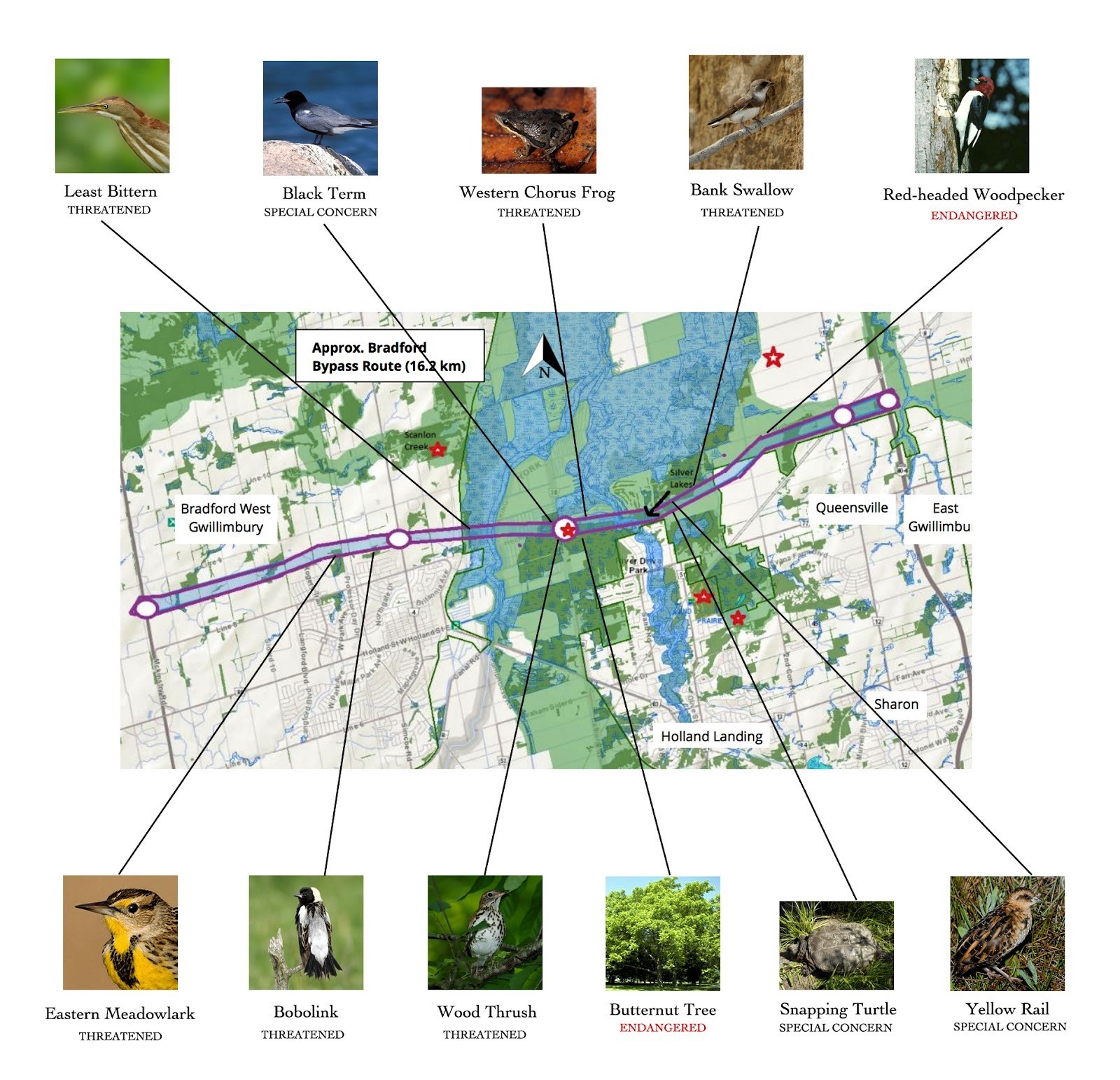
The GTA West Corridor (top) and the Bradford Bypass, the two key PC government projects under its highway scheme to trigger more development, will harm the habitat of close to 40 species at risk according to previous investigations by The Pointer.
(Map and images Joel Wittnebel/The Pointer)
Nowhere in the documentation created as part of the 10-year review mentioned by Piccini’s office is it stated that protections for species at risk should be weakened. Any legislation that does would effectively be working against the stated purpose of the ESA.
A legal analysis from the Canadian Environmental Law Association (CELA), stated Schedule 5 of Bill 108, which gutted power from the ESA, was doing just that.
“CELA concludes that Schedule 5 of Bill 108 represents an unjustified rollback of species protection and recovery actions. In our view, these amendments will result in the status quo of habitat loss and degradation being upheld,” the organization’s submission reads. “Protecting the environment and Ontario’s biodiversity requires directing and encouraging economic growth towards less damaging practices. Without timely and meaningful protection and restoration actions through provincial endangered species law, these species will be lost.”
The PCs approved the Schedule and many of its exemptions anyway.
“The amendments give new powers to the Minister to delay, limit and remove protections for at-risk species. Further, it creates numerous, overlapping pathways for developers and industrialists to dodge critical requirements,” Ontario Nature states on its website. “Those with a vested, short-term economic interest in sprawl development now have free rein to bulldoze, dig up and pave over the habitats of our most vulnerable plants and animals.”
But the PCs did not stop there. In 2020, as part of their COVID-19 recovery omnibus bill, the PCs added forestry operations on Crown Lands to the already long list of practices that are exempt from the ESA.
Lysyk points out in her audit that this was done despite the determination of the government’s own staff members that this would cause harm to 12 endangered or threatened species, including the boreal caribou.
The changes to the ESA in 2020 were so egregious, the federal government has twice reached out to the Province requesting these amendments be changed as they do not align with federal legislation, which Queen’s Park is obligated to comply with.
As of November 2021, no action had been taken on these requests.
There are a number of other misleading claims made by Piccini’s office.
The MPP Liaison refers to “improving transparency when it comes to notifications of new species listings and enhancing government oversight and enforcement powers.”
The PCs have neither been enforcing the ESA, nor listing new species for protection—despite evidence of the dire need for some species to receive legislative help to avoid being wiped out.
Under the previous Liberal government, permitting and inspections still posed significant problems, but species continued to be added to the at-risk list—meaning they could, in theory, receive some level of protection—and fines were laid on those companies not complying with the Act. Between 2008 and 2018, the number of listed species increased from 184 to 243. Since 2018, no new species have been added to the list. Between 2015 and 2017, 91 charges were laid for violations to the ESA; between 2018 and 2020, only 5 charges were laid.
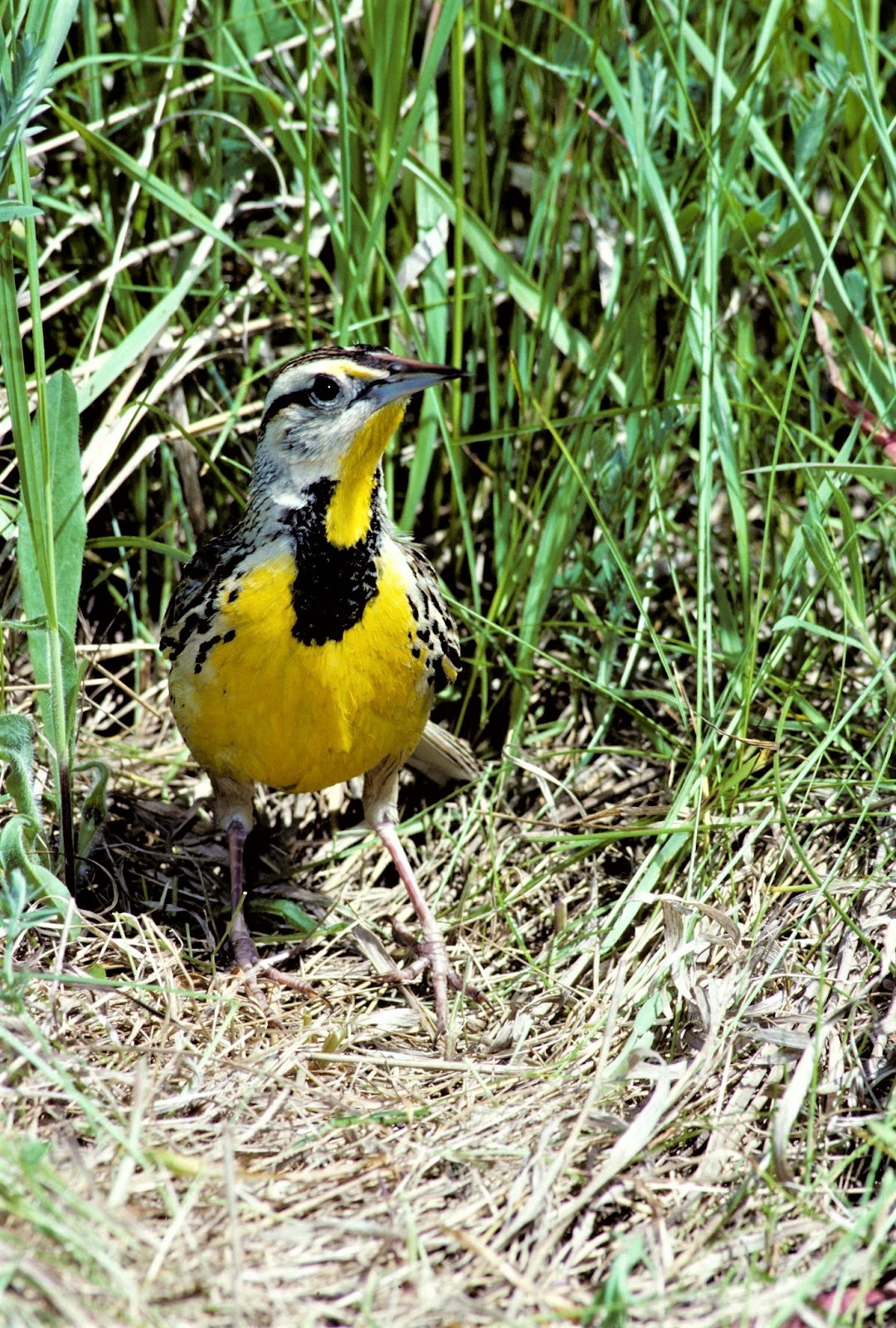
The Eastern Meadowlark is one of the species at risk most commonly impacted by development applications.
(Photo Jim Richards)
Data from Lysyk show that once the Liberals were ousted from power in 2018, the listing of new species and fines levied under the Act fell off a cliff.
Piccini’s liaison references improvements to transparency. However, Lysyk found the PC government is being anything but open when it comes to the changes they propose to environmental legislation like the ESA.
“In our review of permits, we noted that the language was sometimes oversimplified and misleading in proposal notices on the Environmental Registry,” Lysyk states, referencing an example from 2021 for a subdivision permit that ministry staff had found would damage 3.1 hectares and destroy 18.8 hectares of habitat for the eastern fox snake and Butler’s garter snake.
“The proposal notice on the Environmental Registry described that the activity ‘may impact’ the habitat of the two species. Ministry staff removed all references relating to killing, harming, harassing, damaging, and destroying—all of which are the prohibited activities spelled out in the Act—which would have helped the public better understand the nature of the proposal, and make informed comments on whether the permit should be issued,” Lysyk states. “We reviewed a sample of proposed permits posted on the Environmental Registry since 2019 and found that 52 percent contained similar understated language. Staff selected the understated wording of ‘may impact’ at the preference of the Minister’s office.”
It’s unclear what “transparency” improvements Piccini’s spokesperson is referencing, when Lysyk has found that direction is coming directly from the Minister’s office to use language that will hide just how damaging development applications can be for species at risk.
It’s another example of how egregiously misleading the Minister is being.
The response to Richards, the constituent, continued: “We have created the Species-at-Risk Conservation Fund and have now launched the Species-at-Risk Action Agency. We are bringing together a group of experts and scientists to invest in strategic, large-scale, and coordinated actions that would support more positive outcomes for select species-at-risk.”
While the PC government labels it a “conservation fund”, environmental groups describe it as a “pay to slay” fund.
The new system created under the PC government allows developers to pay into the fund in exchange for allowances to harm certain species at risk.
“Rather than having to undertake on-the-ground actions to compensate for damage done, those businesses will be able to pay into the fund and then wash their hands of any further responsibility,” reads a release from Environmental Defence.
“By making it quick and easy, the fund provides a perverse incentive for destruction,” states Dr. Anne Bell of Ontario Nature in the same press release. “It’s blood money from those who want to rip up or pave over the forests, fields and wetlands where species at risk persist.”
The ability of developers to simply pay for destroying delicate habitat is made even more ineffective by the PC government’s utter failure to even attempt to properly create new spaces for these at-risk animals (an idea conservationists have proved is ineffective because it’s very difficult to build life-sustaining habitat for certain species). The amount of habitat being destroyed does not equal the amount that is replaced elsewhere.
A review completed by the Natural Resources Ministry in 2018 discovered developers were following through with the set mitigation goals in the permit only 42 percent of the time.
It’s clear many of these permits do not provide an “overall benefit”.
In one particular case, a company destroyed 9.6 hectares of different types of habitat for the Blanding’s Turtle, and was only required to create 0.49 hectares elsewhere. Monitoring reports showed that no turtles had inhabited the created pond two years after it had been constructed.
In another example, a pair of permits issued in 2021 allowed the damaging or destruction of 51.6 hectares of habitat for the Blanding’s turtle, and required only 1.8 hectares to be created.
This level of carelessness even extends to government agencies. The Ministry of Transportation obtained a permit in 2021 to destroy 0.46 hectares of habitat of the redside dace, and was only required to create or enhance 0.08 hectares elsewhere.
Further reviews found that habitat recreation measures often do not work, the restoration is often done in unsuitable locations or habitat, and in order to get approvals pushed through faster, work is often completed without taking into consideration the nuances of different species and their needs.
Lysyk highlighted that the federal government had particular concerns with certain species, like the Blanding’s Turtle, being involved with the Fund as it had the potential to harm the species, which is endangered across the globe.
The government argues that the Conservation Fund will benefit species at risk as the money received would be designated for conservation projects. However, there is no requirement that the conservation project funded would be in the same area where the harm was taking place, creating the potential for key habitats to be lost. The PC government has shown itself to not prioritize permits for conservation work, creating the potential for these to be delayed.
The response on behalf of Piccini concludes by saying the government has invested more than $16 million since 2018. The PCs have invested $4.5 million into the program annually since being elected; the funds were reduced from an annual investment of $5 million in 2017. The PCs have not restored the additional funding.

Ontario Environment Minister David Piccini has not addressed criticism about his failure to protect species at risk, instead having staffers respond to the media and public.
(Photo government of Ontario)
The Pointer did not receive a response from Piccini’s liaison when attempting to get clarification on his misleading response to Richards. However, Minister Piccini’s press secretary responded, attempting to push back against some of the criticisms levelled by Lysyk in her audit, repeating many of the misleading claims made to Richards. It’s unclear why questions sent by members of the public and the media, specifically asking for answers from elected officials, are instead handled by gatekeepers. It’s also unclear if they have the expertise to provide accurate answers.
“In 2019, we did indeed modernize and improve the effectiveness of the Endangered Species Act, 2007 by implementing recommendations received as part of the 10-year review of the Act, including improving transparency when it comes to notifications of new species listings and enhancing government oversight and enforcement powers,” Press Secretary Andrew Kennedy states in an emailed response. “To your question on this point, we have prepared response statements for 164 (or 98%) of the 168 species currently requiring a response statement, with more underway, and we track progress towards meeting recovery goals through Review of Progress reports. These materials are researched and developed by expert staff at the Ministry of the Environment, Conservation and Parks and suggestions to the contrary would be a misrepresentation.”
The assertion that “we” or the PC government, have prepared the 164 response statements—documents designed to lay out a path forward for conserving a species at risk—does not appear to be true. The government’s own website includes response statements prepared before the PCs were elected in 2018. If 164 response statements have been prepared since, it’s expected that they would be listed on the website. They are not. It remains unclear how many the PCs have completed since being elected.
Lysyk found that these response statements are “generally insufficient” to improve the status of species at risk.
“We found that the province’s goals are generally less ambitious than the scientific advice in recovery strategies, and that government-led actions are often not specific to the species and include meeting existing legal obligations. Additionally, response statements do not establish performance measures or provide cost estimates to help inform decisions about which protection and recovery actions to take or prioritize,” Lysyk states. “Accordingly, the Environment Ministry does not have any objective or systematic way of knowing whether any actions being taken are making a difference. As a result of these weaknesses, implementing response statement actions may not improve the status of species at risk.”
“Ontario is a leader in species at risk protection and legislation as we have a mandatory science-based assessment and classification process,” Kennedy states in his response to The Pointer. “Our government and our partners are doing incredible things for conservation in our province. It is thanks to successful education and outreach that our government has undertaken that we have been able to fully resolve the vast majority of complaints received.”
The vast majority of the recommendations made in Lysyk’s audit to improve the Species at Risk framework, were ignored by the PC government.
“The Ministries' completely unresponsive reply to these seemingly irrefutable facts and conclusions is pathetic and negligent and a disservice to all Ontarians—not just the species being eradicated—as our biodiversity is fundamental to the long-term sustainability and health of the province,” says Victor Doyle, a former Ontario government land use planner and author of the Greenbelt Plan.
Richards says he was dismayed by the response from his local PC representative, who is also the Environment Minister.
"David Piccini was elected to represent the views of the people, not just the oil, lumber and other government lobbyists," Richards states. "That the Ford government has gutted most environmental protection in our province is a shame and travesty."
Email: [email protected]
Twitter: @JoeljWittnebel
COVID-19 is impacting all Canadians. At a time when vital public information is needed by everyone, The Pointer has taken down our paywall on all stories relating to the pandemic and those of public interest to ensure every resident of Brampton and Mississauga has access to the facts. For those who are able, we encourage you to consider a subscription. This will help us report on important public interest issues the community needs to know about now more than ever. You can register for a 30-day free trial HERE. Thereafter, The Pointer will charge $10 a month and you can cancel any time right on the website. Thank you
Submit a correction about this story


